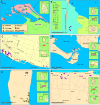Salinity-tolerant larvae of mosquito vectors in the tropical coast of Jaffna, Sri Lanka and the effect of salinity on the toxicity of Bacillus thuringiensis to Aedes aegypti larvae
- PMID: 23174003
- PMCID: PMC3533938
- DOI: 10.1186/1756-3305-5-269
Salinity-tolerant larvae of mosquito vectors in the tropical coast of Jaffna, Sri Lanka and the effect of salinity on the toxicity of Bacillus thuringiensis to Aedes aegypti larvae
Abstract
Background: Dengue, chikungunya, malaria, filariasis and Japanese encephalitis are common mosquito-borne diseases endemic to Sri Lanka. Aedes aegypti and Aedes albopictus, the major vectors of dengue, were recently shown to undergo pre-imaginal development in brackish water bodies in the island. A limited survey of selected coastal localities of the Jaffna district in northern Sri Lanka was carried out to identify mosquito species undergoing pre-imaginal development in brackish and saline waters. The effect of salinity on the toxicity of Bacillus thuringiensis israelensis larvicide to Ae. aegypti larvae at salinity levels naturally tolerated by Ae. aegypti was examined.
Methods: Larvae collected at the selected sites along the Jaffna coast were identified and salinity of habitat water determined in the laboratory. The LC₅₀ and LC₉₀ of B. thuringiensis toxin, the active ingredient of a commercial formulation of the larvicide BACTIVEC®, were determined with Ae. aegypti larvae. Bioassays were also carried out at salinities varying from 0 to 18 ppt to determine the toxicity of Bacillus thuringiensis to fresh and brackish water-derived larvae of Ae. aegypti.
Results: Larvae of four Anopheles, two Aedes, one Culex and one Lutzia species were collected from brackish and saline sites with salinity in the range 2 to 68 ppt. The LC₅₀ and LC₉₀ of B. thuringiensis toxin for the second instar larvae of Ae. aegypti in fresh water were 0.006 ppm and 0.013 ppm respectively, with corresponding values for brackish water populations of 0.008 and 0.012 ppm respectively. One hundred percent survival of second instar fresh water and brackish water-derived Ae. aegypti larvae was recorded at salinity up to 10 and 12 ppt and 100% mortality at 16 and 18 ppt, yielding an LC₉₀ for salinity of 13.9 ppt and 15.4 ppt at 24 h post-treatment respectively for the two populations. Statistical analysis showed significantly reduced toxicity of B. thuringiensis to fresh and brackish water-derived Ae. aegypti larvae at high salinities.
Conclusion: A variety of mosquito vectors of human diseases undergo pre-imaginal development in brackish or saline waters in coastal areas of the Jaffna district in northern Sri Lanka. Salinity has a small but significant negative impact on the toxicity of B. thuringiensis toxin to Ae. aegypti larvae at salinity levels where Ae. aegypti larvae are found in the environment. This has implications for the use of B. thuringiensis toxin as a larvicide in brackish waters.
Figures



Similar articles
-
Biological differences between brackish and fresh water-derived Aedes aegypti from two locations in the Jaffna peninsula of Sri Lanka and the implications for arboviral disease transmission.PLoS One. 2014 Aug 29;9(8):e104977. doi: 10.1371/journal.pone.0104977. eCollection 2014. PLoS One. 2014. PMID: 25170879 Free PMC article.
-
Salinity tolerant Aedes aegypti and Ae. albopictus-Infection with dengue virus and contribution to dengue transmission in a coastal peninsula.J Vector Borne Dis. 2018 Jan-Mar;55(1):26-33. doi: 10.4103/0972-9062.234623. J Vector Borne Dis. 2018. PMID: 29916445
-
Wolbachia infection is widespread in brackish and fresh water Aedes albopictus (Diptera: Culicidae) in the coastal Jaffna peninsula of northern Sri Lanka.J Vector Borne Dis. 2023 Apr-Jun;60(2):172-178. doi: 10.4103/0972-9062.361165. J Vector Borne Dis. 2023. PMID: 37417166
-
Larvicidal activity of terpenes and their derivatives against Aedes aegypti: a systematic review and meta-analysis.Environ Sci Pollut Res Int. 2024 Dec;31(56):64703-64718. doi: 10.1007/s11356-024-35479-w. Epub 2024 Nov 16. Environ Sci Pollut Res Int. 2024. PMID: 39549195
-
Role of Lectin in the Response of Aedes aegypti Against Bt Toxin.Front Immunol. 2022 May 13;13:898198. doi: 10.3389/fimmu.2022.898198. eCollection 2022. Front Immunol. 2022. PMID: 35634312 Free PMC article. Review.
Cited by
-
Molecular characterization of the malaria vector Anopheles barbirostris van der Wulp in Sri Lanka.Parasit Vectors. 2014 Jul 29;7:348. doi: 10.1186/1756-3305-7-348. Parasit Vectors. 2014. PMID: 25073899 Free PMC article.
-
Persistence and recycling of bioinsecticidal Bacillus thuringiensis subsp. israelensis spores in contrasting environments: evidence from field monitoring and laboratory experiments.Microb Ecol. 2014 Apr;67(3):576-86. doi: 10.1007/s00248-013-0360-7. Epub 2014 Jan 9. Microb Ecol. 2014. PMID: 24402370
-
Effect of salinity on the oviposition and growth of Ochlerotatus togoi.Ecol Evol. 2024 Apr 23;14(4):e11289. doi: 10.1002/ece3.11289. eCollection 2024 Apr. Ecol Evol. 2024. PMID: 38660469 Free PMC article.
-
Bionomic aspects of dengue vectors Aedes aegypti and Aedes albopictus at domestic settings in urban, suburban and rural areas in Gampaha District, Western Province of Sri Lanka.Parasit Vectors. 2022 Apr 27;15(1):148. doi: 10.1186/s13071-022-05261-3. Parasit Vectors. 2022. PMID: 35477476 Free PMC article.
-
Eco-friendly microbial route to synthesize cobalt nanoparticles using Bacillus thuringiensis against malaria and dengue vectors.Parasitol Res. 2013 Dec;112(12):4105-12. doi: 10.1007/s00436-013-3601-2. Epub 2013 Sep 8. Parasitol Res. 2013. PMID: 24013343
References
-
- World Health Organization. Dengue Guidelines for Diagnosis, Treatment, Prevention and Control. 2011. http://whqlibdoc.who.int/publications/2009/9789241547871_eng.pdf (Accessed July 12, 2011) - PubMed
-
- Cavrini F, Gaiban P, Pierro AM, Rossini G, Landini MP, Sambri V. Chikungunya: an emerging and spreading arthropod-borne viral disease. J Infect Dev Ctries. 2009;3:744–752. - PubMed
-
- Epidemiology Unit. Ministry of Healthcare and Indigenous Medicine, Sri Lanka. 2012. http://www.epid.gov.lk/web/index.php?option=com_casesanddeaths&Itemid=44....
-
- Surendran SN, Kannathasan S, Kajatheepan A, Jude PJ. Chikungunya-type fever outbreak: some aspects related to this new epidemic in Jaffna district, northern Sri Lanka. Trop Med Health. 2007;35:249–252. doi: 10.2149/tmh.35.249. - DOI
MeSH terms
Substances
LinkOut - more resources
Full Text Sources

